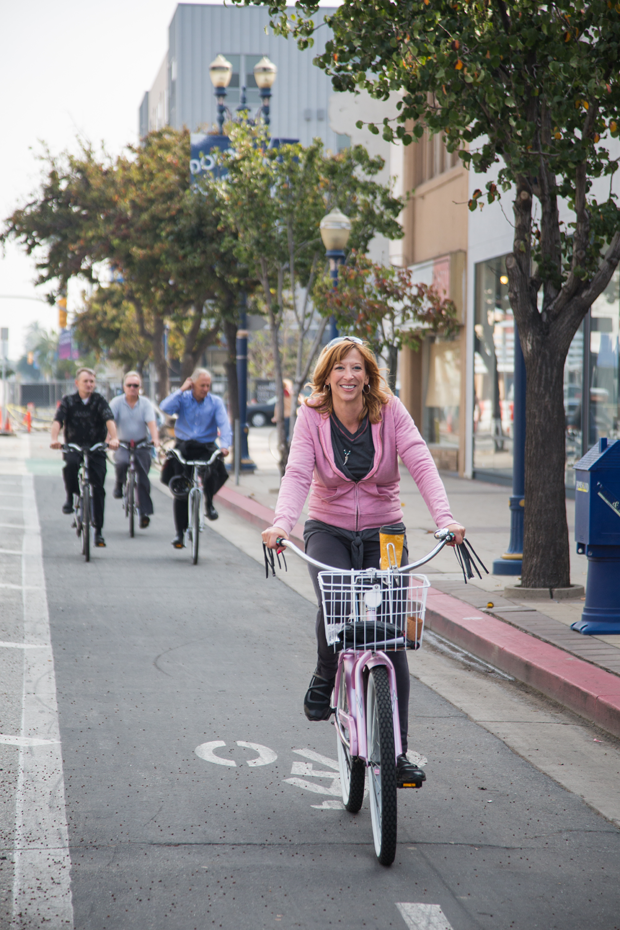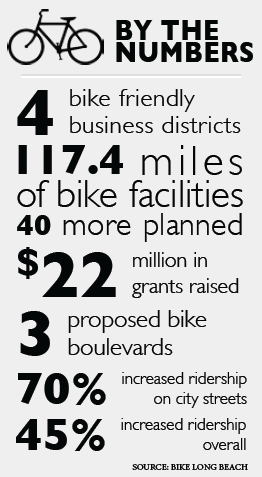
Photos by Samuel Lippke
By Sarah Bennett and Brian Addison | Though the story of the Long Beach Cyclist should technically begin in 1996 with the nation’s first BikeStation— a European-inspired non-profit where one can rent, store and park their bikes—the real cycling momentum started to pick up in 2009 when the City Council voted to take on the slogan of “The Most Bicycle- Friendly City In America.”
 The course of action over the past few years has not only proven fruitful, it has transformed Long Beach into a national model of biking infrastructure for a midsize city, with even larger cities—Los Angeles, namely— directly molding their own biking initiatives after our own.
The course of action over the past few years has not only proven fruitful, it has transformed Long Beach into a national model of biking infrastructure for a midsize city, with even larger cities—Los Angeles, namely— directly molding their own biking initiatives after our own.
Noticeable change began when the City created the Bike Long Beach program, raising more than $22 million in state and federal grants to improve its bike system. It began by spending funds on resurfacing streets to include new bike lanes as well as painting and paving more than 100 miles of bike infrastructure, but the results went beyond mere paving and painting and made Long Beach home to some of the most cuttingedge experiments in bike-friendliness.
The green sharrows along 2nd Street were only the second to be painted in the country. Converting Vista into a breezy bike boulevard marked L.A. County’s first attempt at such a concept. The bike corrals installed in Downtown and the East Village Arts District were also County firsts. 1800 stylized bike racks were put in— the largest amount ever ordered by a municipality. And last spring, Long Beach unveiled the first protected bike lanes to be built outside of New York City. But of course, building infrastructure is useless if there are no cyclists to utilize it and this is where our Person of the Year comes in.
When Long Beach began to spend its grant money on these amenities, a common myth was that these additions would sit unused (“I never see anyone riding a bike!” claimed the pundit in his car, frustrated at the loss of a car lane Downtown).
 In actuality, this year alone saw a 29 percent rise in ridership across the city’s current 125 mile-network of bikable streets, paths, bike lanes, bike boulevards and sharrows—the largest annual increase the city has seen since the initiative began.
In actuality, this year alone saw a 29 percent rise in ridership across the city’s current 125 mile-network of bikable streets, paths, bike lanes, bike boulevards and sharrows—the largest annual increase the city has seen since the initiative began.
The City may have laid the structural foundation for bike-friendliness, but it was Long Beach residents that stepped up to the challenge to de-car their lives. Hopping on beach cruisers, hybrid bikes, BMXs, fixed gears, road bikes and every style in between, riders of all types are increasingly ubiquitous on city streets. Some made documentaries like Riding Bikes With The Dutch and organized bike-safety courses to explore how cycling can be easily incorporated into the daily urban existence. Others organized weekly rides—from racing hard on fixedgears to cruising on vintage bikes—one for nearly each day of the week. And many more one-time Long Beach drivers simply decided to ditch the cost-andparking hassle of a car to become one of the city’s nearly 4000-and-counting selfidentified cyclists.
 With a growing infrastructure in place and such a staggering increase in ridership over the last few years, businesses and advocates couldn’t help but respond. Bicycle-friendly business districts were created; discounts began to be offered for those who cycled in. A non-profit bike co-op was founded to train bike mechanics and help low-income riders find affordable parts. Long Beach got its first pedi-cab business. It also began offering its first bicycle tours. Bike shops sprouted up across the city— eight new ones opened in 2012 alone—becoming not only places to get a tire pumped, but major lifestyle hubs offering everything from clothing to community events.
With a growing infrastructure in place and such a staggering increase in ridership over the last few years, businesses and advocates couldn’t help but respond. Bicycle-friendly business districts were created; discounts began to be offered for those who cycled in. A non-profit bike co-op was founded to train bike mechanics and help low-income riders find affordable parts. Long Beach got its first pedi-cab business. It also began offering its first bicycle tours. Bike shops sprouted up across the city— eight new ones opened in 2012 alone—becoming not only places to get a tire pumped, but major lifestyle hubs offering everything from clothing to community events.
 By taking advantage of all of the twowheeled options in the city, the Long Beach Cyclist this year helped make greater-than-ever gains towards Long Beach’s goal of becoming the most bike friendly city in the country. After attaining our Silver Bicycle Friendly Community status from the League of American Cyclists, L.A County Supervisor Zev Yaroslavsky came to Long Beach in August with a team of county engineers to look at strategies Long Beach uses in order to apply them county-wide.
By taking advantage of all of the twowheeled options in the city, the Long Beach Cyclist this year helped make greater-than-ever gains towards Long Beach’s goal of becoming the most bike friendly city in the country. After attaining our Silver Bicycle Friendly Community status from the League of American Cyclists, L.A County Supervisor Zev Yaroslavsky came to Long Beach in August with a team of county engineers to look at strategies Long Beach uses in order to apply them county-wide.
 Four major mobility conferences were also held in Long Beach this year (the Pro Bike/Pro Walk Conference, the Congress for New Urbanism, the Alliance for Biking and Walking, and the inaugural National Women’s Bicycling Summit)—which collectively drew in some $2 million in direct financial impact for the city—our beachfront locale chosen for both our infrastructure and our passionate bike community. “Long Beach,” in the words of Streetsblog editor and alternative-mobility activist Damien Newton, “is the model for bicycling infrastructure for a midsize city.”
Four major mobility conferences were also held in Long Beach this year (the Pro Bike/Pro Walk Conference, the Congress for New Urbanism, the Alliance for Biking and Walking, and the inaugural National Women’s Bicycling Summit)—which collectively drew in some $2 million in direct financial impact for the city—our beachfront locale chosen for both our infrastructure and our passionate bike community. “Long Beach,” in the words of Streetsblog editor and alternative-mobility activist Damien Newton, “is the model for bicycling infrastructure for a midsize city.”
It was not only the grants and infrastructure that put Long Beach on the map, but the fact that these amenities are increasingly being used every day and by an array of cyclists as diverse as the city itself.
Of course Long Beach’s progress is hardly complete in this regard and there are many more people who have yet to give up their cars. But the important role of the local cyclist—and why we have designated them the Person of the Year— is that they have not just altered our perception of what transportation can be, but they are also responsible for the growing status of Long Beach as a city that others can look to as a role model. And that is more powerful than any numbers.


